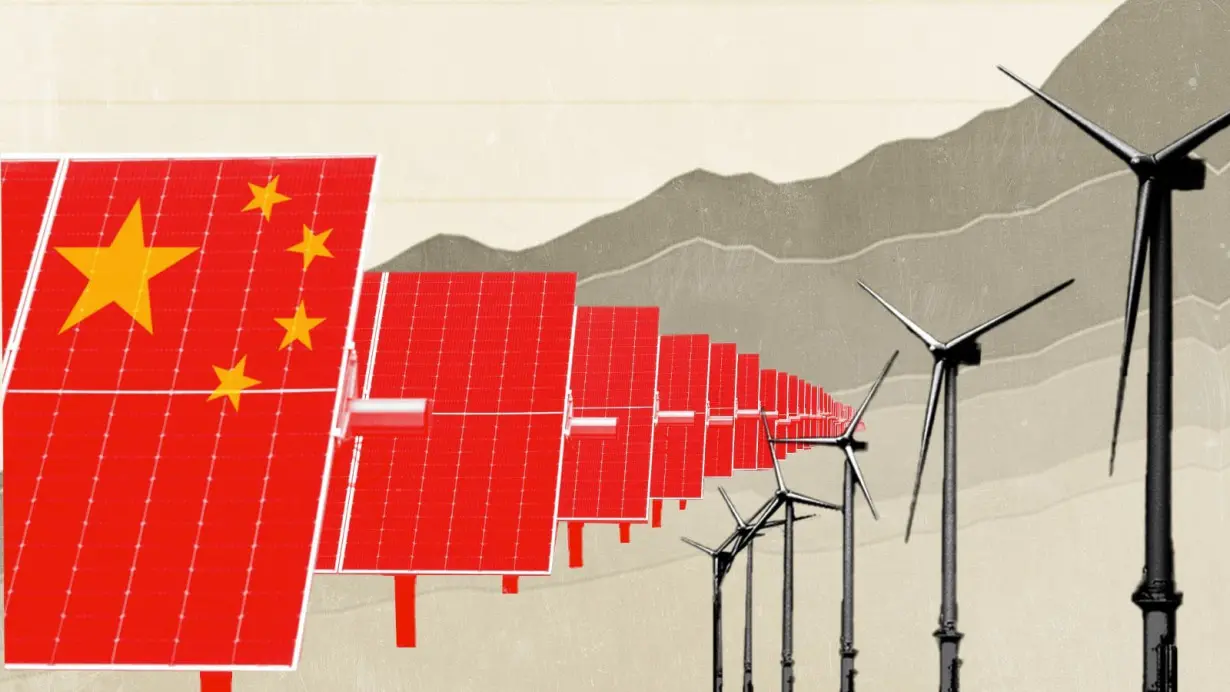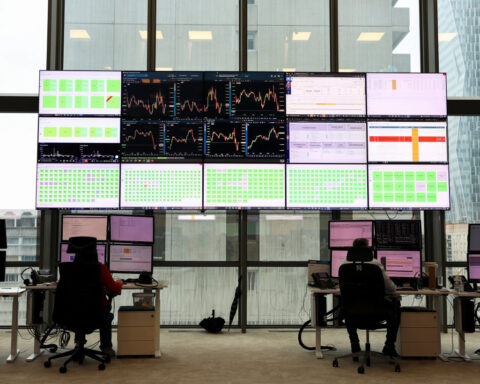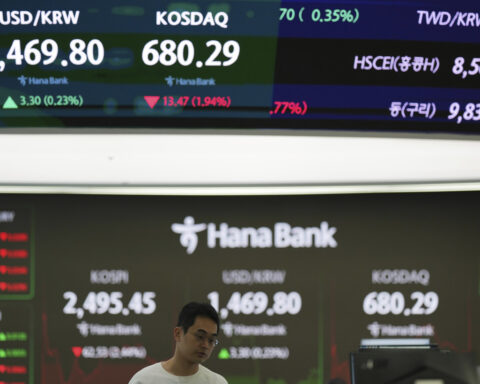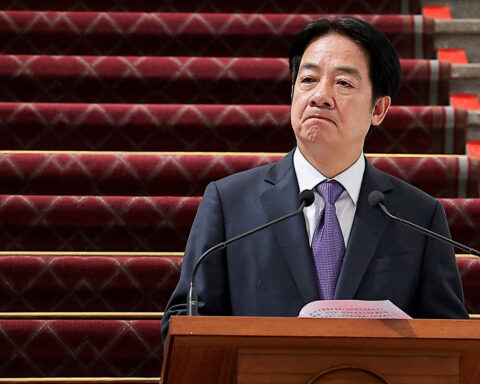(CNN) — High above the sand dunes of China’s Kubuqi desert, nearly 200,000 solar panels have been carefully placed in rows to create the outline of a galloping steed.
The giant horse is a cultural symbol for Inner Mongolia, the northern Chinese region where the massive Junma solar farm is located — but it also signifies the speed at which China is racing toward a clean energy future.
China is installing wind and solar power projects faster than any other country on the planet. As President-elect Donald Trump is likely to roll back on the US’ role as a global climate leader, experts say China will have to lead the charge.
And as the world’s biggest polluter of planet-heating carbon, China has more power than any other nation to put a dent in global emissions.
The country accounted for a tiny fraction of the world’s carbon pollution at the turn of the 20th century, but its emissions surged as it rapidly transformed into the world’s factory and, more recently, a powerful tech innovator. It’s now the world’s biggest carbon polluter by far, accounting for nearly a third of global planet-heating emissions.
Carbon pollution is worryingly at an all-time high, but there’s a glimmer of hope: emissions growth in China is slowing. Some climate experts and senior US officials think China’s emissions will soon peak and fall.
A downturn couldn’t come any sooner. The year 2024 is on track to be the hottest on record, and scientists say humanity is fast running out of time to stop burning fossil fuels and avoid the most catastrophic outcomes of climate change.
It’s not that China is using less energy — it’s using more than ever — but it’s just adding wind and solar power to its grid at an astonishing pace.
“It’s extraordinary,” said Jonathan Pershing, a former State Department climate diplomat who now directs the William and Flora Hewlett Foundation’s environment program. “I look at it and say, this is kind of what we want the world to do.”
China, for all its world-heating pollution, is a global renewables powerhouse.
The country is constructing two-thirds — nearly 339 gigawatts — of the world’s utility-scale solar and wind projects. That would be enough to power more than 250 million homes, nearly double the number of homes that exist in the US. That is in addition to the 758 gigawatts of wind and solar capacity it has already built, according to the Global Energy Monitor.
Chinese solar is now expanding so fast that by the early 2030s, the country will generate more power from the sun than the amount of electricity the US will consume altogether, according to the International Energy Agency.
China is also leading the world in exporting solar panels around the globe — with the majority going to Europe and noticeable growth in Africa. The US, meanwhile, has put restrictions on Chinese solar imports due to forced labor concerns, and is focusing on building out its own domestic supply chain for solar.
While many Western nations make ambitious climate reduction targets only to miss them, China has a tendency to under-promise and over-perform, said John Podesta, White House senior advisor for international climate policy.
“In some of their planning scenarios, they’re planning for 100 gigawatts a year, but they’re building at close to 300 gigawatts a year,” Podesta told CNN. Chinese President Xi Jinping previously committed to constructing 1,200 gigawatts of renewable generation by 2030 – a target the nation has hit six years ahead of schedule.
The bigger question now is whether this clean energy will also lead to coal plant retirements. Wind and solar are now capable of generating 37% of the country’s power, according to Global Energy Monitor, already displacing coal’s dominance. China is retiring its oldest coal plants and operating others less, but it hasn’t stopped building new plants. “I think they probably need to go further in the next decade to begin to retire that coal-fired power,” Podesta said. “They have the capacity to do that.”
Podesta told CNN the US believes China is in the “throes” of peaking. How fast and far they now cut those emissions has enormous implications for the planet.
China’s current climate commitment is to peak its planet-warming pollution sometime before 2030. For the next round of climate commitments, due in February, Podesta and US officials are urging China to cut their emissions 30% by 2035 – a steep drop.
“The world is looking for a significant commitment to reduce emissions by the world’s largest emitter. They’d do well to come forward with a significant cut.”
The amount of global warming that could be avoided by such a cut is huge. If China cuts its climate pollution by the 30% US officials suggest, it would save 4.7 gigatons from entering the atmosphere. That’s the same amount the US is projected to pollute this year, according to State Department officials.
CNN has reached out to China’s Ministry of Foreign Affairs for comment. In a recent press briefing, Department of Climate Change director Xia Yingxian said China was actively considering its 2035 target for cutting emissions, which all countries party to the Paris Agreement are obliged to announce next year.
It’s tough to forecast exactly when China’s emissions will peak, or if they already have. Recent independent analysis by UK-based climate website Carbon Brief found China’s emissions fell by 1% earlier this year, the first time the country registered an emissions decline since Covid-19 shuttered its economy.
Experts also say it’s too soon to say whether this drop is evidence of a sustained trend. And a 1% drop is not nearly enough to hit the Chinese government’s own climate targets for next year.
But what’s clear is a fundamental shift is underway in China’s economy. As China’s post-Covid infrastructure boom has slowed, so too has demand for heavy industry materials like cement and steel. Manufacturing of solar panels and electric vehicles, meanwhile, is ramping up.
“I want to be cautious here, but we are seeing a U-turn in the last few months,” Li Shuo, director of the China climate hub at the Asia Society Policy Institute, told CNN.
Since 2015, China has been responsible for 90% of global emissions growth, Shuo said, so its emissions plateauing “would definitely mean that global emissions will peak and plateau.”
“This will mark a very significant turning point in the global effort to combat climate change,” Shuo said. “This will still be an insufficient first step. But I think nevertheless, it is important milestone.”
The-CNN-Wire
™ & © 2024 Cable News Network, Inc., a Warner Bros. Discovery Company. All rights reserved.

 Trump has begun another trade war. Here's a timeline of how we got here
Trump has begun another trade war. Here's a timeline of how we got here
 Canada's leader laments lost friendship with US in town that sheltered stranded Americans after 9/11
Canada's leader laments lost friendship with US in town that sheltered stranded Americans after 9/11
 Chinese EV giant BYD's fourth-quarter profit leaps 73%
Chinese EV giant BYD's fourth-quarter profit leaps 73%
 You're an American in another land? Prepare to talk about the why and how of Trump 2.0
You're an American in another land? Prepare to talk about the why and how of Trump 2.0
 Chalk talk: Star power, top teams and No. 5 seeds headline the women's March Madness Sweet 16
Chalk talk: Star power, top teams and No. 5 seeds headline the women's March Madness Sweet 16
 Purdue returns to Sweet 16 with 76-62 win over McNeese in March Madness
Purdue returns to Sweet 16 with 76-62 win over McNeese in March Madness








